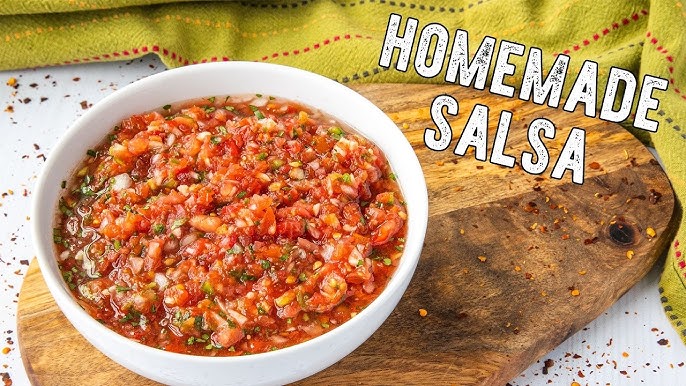Best Salsa Recipe: Let’s be real—store-bought salsa just doesn’t hit the same as homemade. Making salsa at home gives you full control over the flavor, freshness, and texture. You get to decide the heat level, how chunky or smooth it is, and you avoid all those preservatives you find in jars off the shelf. Homemade salsa is a game-changer for taco nights, parties, or just as a snack with tortilla chips.
Not to mention, it’s crazy easy to make. You don’t need to be a professional chef or have fancy gadgets. Just a blender or food processor, some fresh ingredients, and about 10 minutes of your time. That’s it. Plus, once you get the hang of it, you’ll never go back to store-bought.
The Versatility of Salsa
Salsa isn’t just for chips. This magical condiment can take a bland meal and transform it into something bold and zesty. Toss it on grilled chicken, spoon it over eggs, stir it into rice, or use it as a topping for burgers. Whether you like it hot and spicy or mild and tangy, there’s a salsa variation for everyone.
It also plays well with a ton of cuisines—not just Mexican. With a few swaps, you can turn it into a tropical pineapple salsa, a smoky chipotle version, or even a tangy salsa verde. The possibilities are endless!
Essential Ingredients for the Best Salsa
Fresh Produce You’ll Need
The foundation of any good salsa is fresh ingredients. Here’s what you’ll need for a classic tomato-based salsa:
- Tomatoes: Go for Roma tomatoes or vine-ripened ones. They have less water and more flavor.
- Onion: White or red both work, but white is more traditional.
- Garlic: Just one or two cloves go a long way.
- Cilantro: Fresh cilantro brings that signature herby brightness.
- Jalapeño or Serrano Peppers: Choose based on your spice tolerance.
- Lime Juice: Adds acidity and freshness.
- Salt: To bring all the flavors together.
Make sure everything is fresh—no wrinkly tomatoes or limp cilantro. Your salsa will only be as good as the stuff you put into it.
Optional Add-Ins to Customize Your Salsa
If you’re the type who likes to put your own spin on things, here are a few optional extras you can toss in:
- Cumin: Adds a warm, earthy note.
- Sugar: Just a pinch can balance acidity if your tomatoes are super tart.
- Tomato Paste: For extra thickness and depth.
- Roasted Red Peppers: For a sweet, smoky flavor.
- Chipotle Peppers in Adobo: If you want that smoky heat.
These aren’t must-haves, but they let you tweak the salsa to fit your taste. Don’t be afraid to experiment!
Step-by-Step Instructions to Make Salsa
Step 1: Prepping the Ingredients
First things first—wash all your produce thoroughly. Then start chopping:
- Quarter your tomatoes.
- Roughly chop the onion.
- Peel the garlic.
- Slice the jalapeño (remove seeds if you want it milder).
- Cut a handful of cilantro leaves.
You don’t need to be super precise with chopping since it’s all going in the blender, but smaller pieces help it blend evenly.
Step 2: Roasting or Using Fresh?
Here’s where the magic happens. You’ve got two routes:
- Fresh Salsa: Toss everything raw into the blender. Super quick and fresh-tasting.
- Roasted Salsa: Roast the tomatoes, garlic, and onion in a hot skillet or under the broiler until they’re charred. This adds a smoky, deeper flavor that’s next level.
If you’ve got the time, roasting is worth the extra step. It brings out sweetness in the tomatoes and gives the salsa that irresistible restaurant-style flavor.
Step 3: Blending to the Right Texture
Now it’s blender time. Add everything into the blender or food processor:
- Tomatoes
- Onion
- Garlic
- Cilantro
- Jalapeño
- Lime juice
- Salt
Pulse it a few times if you like it chunky, or blend longer for a smoother texture. Totally up to you. Scrape down the sides as needed to keep it even.
Taste it at this stage—you’re looking for a balance of bright, spicy, salty, and tangy.
Step 4: Seasoning and Taste Testing
Once it’s blended, taste it again. Need more salt? A bit more lime juice? Not enough heat? Now’s the time to adjust. You can add a bit of sugar if it’s too acidic or a splash of vinegar if it needs more tang.
This is where you make it yours. Don’t be afraid to experiment and fine-tune.
Step 5: Letting It Sit – Why It Matters
Once it’s perfect, here’s a pro tip: let it sit in the fridge for at least 30 minutes. Trust me, it makes a difference. The flavors meld together, and it gets even better with time.
You can keep it in an airtight container in the fridge for up to 5 days. The flavor just gets richer every day!
Tips for Perfecting Your Salsa
Balancing Acidity and Heat
Here’s the thing about salsa—nailing the balance between acidity and heat is what separates a decent salsa from a truly unforgettable one. Tomatoes already bring some natural acidity to the mix, but sometimes they need a little help. That’s where lime juice or vinegar steps in. A tablespoon or two of lime juice brightens up the whole bowl, giving it that zippy, fresh bite.
Then there’s the heat. Jalapeños are the go-to, but if you’re feeling bold, serrano peppers pack an extra punch. Want to bring the fire? Try habaneros or even ghost peppers—but proceed with caution! The key here is to add a little at a time. Once it’s too spicy, there’s no turning back. Always taste as you go.
If you accidentally go overboard with the heat, here’s a trick: add a chopped-up tomato, a bit of sugar, or even a splash of olive oil to mellow it out. Salsa is all about balance, and a well-balanced salsa sings.
Storage Tips for Freshness and Flavor
So you’ve got a big, beautiful batch of homemade salsa—now what? First rule: store it properly. Pour your salsa into an airtight container, preferably glass, and pop it in the fridge. It’ll stay good for about 5 to 7 days, but most people finish it off way before then.
Want to make it last even longer? You can freeze it! Yes, salsa freezes surprisingly well. Just put it in a freezer-safe container or zip-lock bag, and it’ll keep for up to 3 months. When you’re ready to use it, thaw it in the fridge overnight. The texture might be a bit softer, but the flavor will still be fantastic.
If you’re making salsa for a party, you can prep everything the night before. Just hold off on blending until right before serving to keep that fresh, just-made taste. Or, go ahead and make the whole batch in advance—remember, salsa gets better after sitting for a while.
FAQs about Best Salsa Recipe
Q1: What’s the secret to making the best salsa at home?
The secret lies in using fresh, ripe ingredients—especially tomatoes, onions, garlic, cilantro, and lime. Roasting or charring some of the veggies can also add a smoky depth that elevates your salsa from good to unforgettable.
Q2: Can I use canned tomatoes for salsa?
Yes, you can! Canned tomatoes work great, especially when fresh ones are out of season. Just drain them a bit to avoid watery salsa.
Q3: How long does homemade salsa last?
Stored in an airtight container in the fridge, homemade salsa can last up to 5 days. Just make sure to give it a quick stir before serving.
Q4: Is salsa better fresh or after sitting for a while?
Funny enough, salsa actually gets better with time. Letting it sit for at least an hour allows the flavors to blend beautifully.
Q5: How do I make my salsa less spicy?
Simply use fewer chili peppers or remove the seeds and membranes, which carry most of the heat. Want zero spice? Swap hot peppers with sweet ones like bell peppers.
Q6: Can I freeze salsa?
Yes, but know this—freezing may alter the texture, especially if it’s a chunky salsa. Pureed versions tend to freeze and thaw more gracefully.
Q7: What can I serve salsa with besides chips?
Oh, the possibilities! Use it on tacos, grilled chicken, scrambled eggs, burgers, or even as a zesty salad dressing. Salsa is basically a flavor bomb that goes with almost anything!
Conclusion
And there you have it—a foolproof, step-by-step guide to making the best salsa ever. Whether you’re a salsa newbie or a seasoned chip-dipper, this recipe is your ticket to fresh, flavorful, homemade goodness every time. Once you try it, you’ll wonder why you ever bought it from the store.
Homemade salsa is more than just a dip—it’s a vibe. It brings people together, adds flavor to meals, and honestly, it just tastes better. With a few fresh ingredients, a blender, and a little creativity, you can whip up a salsa that’s tailored exactly to your taste. So grab some chips, get blending, and let the salsa fiesta begin!



